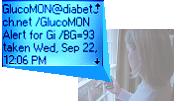Who Needs To Know?
 Share the Data - Step 2 of the Virtual-Loop(TM)
Share the Data - Step 2 of the Virtual-Loop(TM)Assuming we have accurate data from meters, pumps, etc..., what should we do with it besides store it in the device for later review?
In the case of continuous real-time glucose sensors with intelligent alarms, who needs to know about the impending hypoglycemia and the rate of onset? As a friend of mine who is also the parent of a child with type 1 diabetes recently pointed out, automated passive delivery of this critical life-saving information to someone who can help in addition to the patient is a far safer system design than what currently exists on the current investigational stage continuous glucose sensors.
Of course there are endless uses for diabetic data if you can get it, rely on it and ultimately act on it...and understand the effects of specific actions. For example, clinicians typically do not receive timely feedback from patients following prescribed changes to their insulin regimen. In that scenario, the feedback loop is broken and the prescriber too often has no timely insight into whether or not their advice is improving the patient's glycemic control or worsening it. At some future date the clinician will have the A1c to point out averages but that's a far cry from tying intervention to its effect. Unfortunately, the A1c does not illustrate the incidence of hypoglycemia which may have been increased due to the clinicians advice.
What if there was a way to reliably and efficiently close the loop - delivering timely and reliable information to the prescribing clinician about effects from the prescribed change? The Virtual-Loop can... and it doesn't depend on continuous glucose sensors someday in the future.
Technology working together seamlessly for patients, caregivers and clinicians is a beautiful thing.

